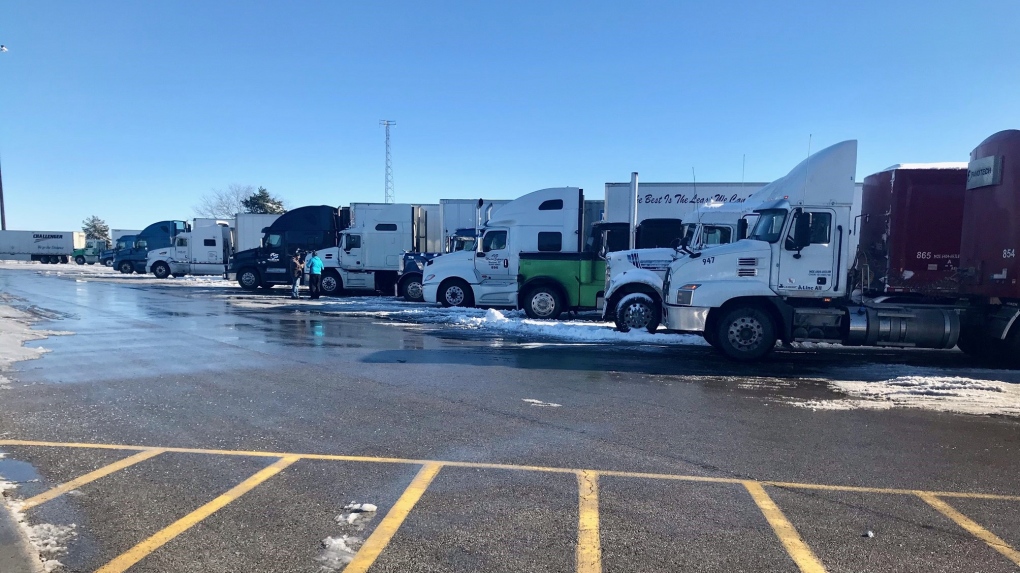
American millionaire Jonathan Lehrer denied bail after being charged with killing Canadian couple
American millionaire Jonathan Lehrer, one of two men charged in the killings of a Canadian couple in Dominica, has been denied bail.
The U.S. trucking industry is short 80,000 drivers, a record high, Chris Spear, President and CEO of the American Trucking Associations, tells CNN.
That's a 30 per cent increase from before the pandemic, when the industry already faced a labor shortage of 61,500 drivers.
"That's a pretty big spike," Spear added. Many drivers are retiring, dropping out of the industry. Increased consumer demand, prompting a need for more drivers, also plays a big role in the shortfall.
This comes at a time when U.S. ports are backlogged -- primarily because there are few trucks and drivers to pick up cargo -- creating a supply chain slowdown. President Biden directed the Ports of Los Angeles and Long Beach to move to 24/7 operations. However, the ports can't yet work round the clock because importers don't have enough drivers to move their cargo at all hours.
"24/7 operations - it's an improvement," said Spear. "But it doesn't matter if it's a port in LA or Long Beach, or the last mile of delivery from a train to a warehouse in Wichita. You're going to have to have a driver and a truck move that freight."
Truck drivers move 71 per cent of the U.S. economy's goods, but represent just 4 per cent of the vehicles on the roads, said Spear. If nothing is done, the latest figures put the industry on track for a shortage of 160,000 drivers by 2030, and the need for 1,000,000 new drivers over the next ten years, according to the American Trucking Associations.
The bipartisan infrastructure bill awaiting action in Congress would authorize hundreds of billions of dollars for transportation, which would include workforce development for the trucking industry. That would allow 3,000 drivers between the ages of 18-20 to undergoing training, permitting them to drive tractor-trailers across state lines. Currently, drivers must be 21 to do so.
Spear believes younger drivers are the key answer to the labor shortage.
"I think that clearly is the most impactful thing that could be done right now to alleviate this problem. So next year, [we] are not going to be having this conversation because it will alleviate itself because we're investing," said Spear.

American millionaire Jonathan Lehrer, one of two men charged in the killings of a Canadian couple in Dominica, has been denied bail.
Cabinet minister Dominic LeBlanc says he plans to run in the next election as a candidate under Prime Minister Justin Trudeau's leadership, amid questions about his rumoured interest in succeeding his longtime friend for the top job.
A male columnist has apologized for a cringeworthy moment during former University of Iowa superstar and college basketball’s highest scorer Caitlin Clark’s first news conference as an Indiana Fever player.
The United States has vetoed a widely backed UN resolution that would have paved the way for full United Nations membership for the state of Palestine.
A group of suspects that allegedly defrauded seniors across Ontario and other parts of Canada using a so-called emergency grandparent scam appear to have ties to 'Italian traditional organized crime,' according to an investigator involved in the OPP-led probe.
Health Canada will change its longstanding policy restricting gay and bisexual men from donating to sperm banks in Canada, CTV News has learned. The federal health agency has adopted a revised directive removing the ban on gay, bisexual and other men who have sex with men, effective May 8.
Prince Harry, the son of King Charles III and fifth in line to the British throne, has formally confirmed he is now a U.S. resident.
Kevin the cat has been reunited with his family after enduring a harrowing three-day ordeal while lost at Toronto Pearson International Airport earlier this week.
Technology from the 19th century has been brought out of retirement at a Newfoundland gardening store, as staff look for all the help they can get to fill orders during a busy season.

Kevin the cat has been reunited with his family after enduring a harrowing three-day ordeal while lost at Toronto Pearson International Airport earlier this week.
Molly Knight, a grade four student in Nova Scotia, noticed her school library did not have many books on female athletes, so she started her own book drive in hopes of changing that.
Almost 7,000 bars of pure gold were stolen from Pearson International Airport exactly one year ago during an elaborate heist, but so far only a tiny fraction of that stolen loot has been found.
When Les Robertson was walking home from the gym in North Vancouver's Lower Lonsdale neighbourhood three weeks ago, he did a double take. Standing near a burrow it had dug in a vacant lot near East 1st Street and St. Georges Avenue was a yellow-bellied marmot.
A moulting seal who was relocated after drawing daily crowds of onlookers in Greater Victoria has made a surprise return, after what officials described as an 'astonishing' six-day journey.
Just steps from Parliament Hill is a barber shop that for the last 100 years has catered to everyone from prime ministers to tourists.
A high score on a Foo Fighters pinball machine has Edmonton player Dave Formenti on a high.
A compound used to treat sour gas that's been linked to fertility issues in cattle has been found throughout groundwater in the Prairies, according to a new study.
While many people choose to keep their medical appointments private, four longtime friends decided to undergo vasectomies as a group in B.C.'s Lower Mainland.
 A truck stop in Dutton, Ontario on Wednesday, December 2, 2020. (Sean Irvine CTV News)
A truck stop in Dutton, Ontario on Wednesday, December 2, 2020. (Sean Irvine CTV News)